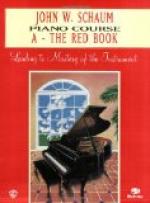“One of the most necessary things is the conserving of vital energy in piano practise,” said the pianist Rudolph Ganz to me one day. “The wrong way is to continually practise the piece as though you were playing it in public—that is to say, with all possible energy and emotion. Some of the pianists now before the public do this, and it always makes me sorry for them, for I know what a needless waste of energy and vital force it is. An actor, studying his lines, does not need to continually shout them in order to learn how they should be interpreted. Neither does the lyric actress practise her roles with full tones, for she is well used to saving her voice. Why then should the pianist exhaust himself and give out his whole strength merely in the daily routine of practise? I grant this principle of saving one’s self may not be easy to learn, but it should be acquired by all players, great and small. I think a pianist should be able to practise five or six hours daily without fatigue. If the player is accustomed to husband his vital force during the daily routine of practise, he can play a long, exacting program in public without weariness. In every day practise one often does not need to play forte nor use the pedals; a tone of medium power is sufficient. Suppose, for instance, you are studying the Chopin Etude Op. 10, No. 12, with the left hand arpeggio work. Every note and finger must be in place, every mark of phrasing obeyed; but during practise hours you need not give the piece all its dashing vigor and bravura at every repetition. Such a course would soon exhaust the player. Yet every effect you wish to make must be thoroughly studied, must be in mind, and used at intervals whenever a complete performance of the piece is desired.
“As I said before, it is often difficult to control the impulse to ’let loose,’ if the work is an exciting one. At a recent rehearsal with the Symphony Orchestra, I told the men I would quietly run through the concerto I was to play, merely indicating the effects I wanted. We began, but in five minutes I found myself playing with full force and vigor.
“In regard to methods in piano study there seems to be a diversity of opinion, resulting, I think, from the various ways of touching the keys—some players using the tip and others the ball of the finger. Busoni may be cited as one who employs the end of the finger—Pauer also; while the Frenchman, Cortot, who has an exquisite tone, plays with the hand almost flat on the keys, a method which certainly insures weight of hand and arm. Of course players generally, and teachers also, agree on the employment of arm weight in playing. The principles of piano technic are surely but few. Was it not Liszt who said: ’Play the right key with the right finger, the right tone and the right intention—that is all!’ It seems to me piano technic has been pushed to its limit, and there must be a reversal; we may return to some of the older methods of touch and technic.




